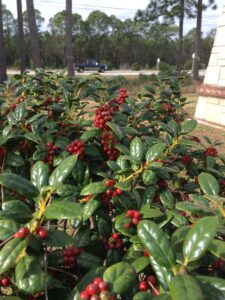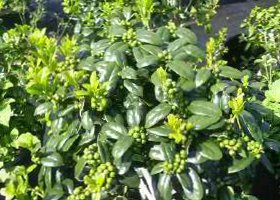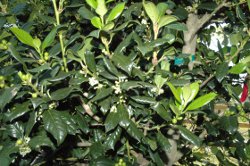S & J Nursery’s
Dwarf Burfordii Holly
for Northeast Florida Landscapes
(Ilex Cornuta Burfordii Nana)
Dwarf Burfordii Holly Origins:
-Dwarf Burfordii Holly is the dwarf form of a very widely planted and popular Burford Holly.
Dwarf Burfordii Holly Preferred Exposure:
– Dwarf Burford Holly prefers a full sun to partial shade location in the North
Florida | Jacksonville | St. Augustine area landscapes.
Dwarf Burfordii Holly Foliage:
– Perhaps even better than this plants bright red showy flowers each winter is the evergreen foliage of the Dwarf Burfordii Holly, it is beautiful dark green and highly glossy. Absolutely a landscape staple for those wanting easy to care for plants or deer proof gardens in North Florida.
Dwarf Burfordii Holly Soil Preference / Salt tolerance:
– Holly plants prefer rich, well drained slightly acid soils but is widely
tolerant of a wide range of soil conditions including sand, clay, loam, extended flooding zones, even well drained non irrigated soils
-Salt tolerance low to medium
 Dwarf Burfordii Holly Size Variance:
Dwarf Burfordii Holly Size Variance:
– Dwarf Burfordii Holly can reach sizes of 4-6+ feet High | 4-6+ feet Wide but is easily maintained as low as 3 ft with just annual pruning.
Dwarf Burfordii Holly Growth Habit:
– Dwarf Burfordii Holly has upright foliage and tends to lend its use best to a more formal boxed hedge.
Dwarf Burfordii Holly Growth Rate:
– Dwarf Burfordii Holly is a slow growing landscape selection, it may require a little patience to get it to the size you would like it to be in the landscape but its low maintenance habit as well as showy winter berries make it worth the wait.
Dwarf Burfordii Holly Bloom:
-Clusters of small white flowers are not very showy in the summer but are followed in fall by clusters of berries that turn a bright Christmas red color just in time for the Holiday season!
– Unlike some Holly species Burford Holly’s are self fertile so there is no
need for a pollinator to get all those pretty berries!!
Dwarf Burfordii Holly Water Requirements:
– Dwarf Burfordii Holly is drought tolerant once established into the
landscape and requires very little attention to daily watering except when first being planted from the nursery containers into the landscape, especially during North Florida | Jacksonville | St. Augustine area’s hot
summer months.
– Burfordii Hollys are an ideal planting for areas that will receive little to
no supplemental irrigation.
– Burfordii Holly will tolerate clay soils with extended flooding
during North Florida’s rainy summer months.
Butterfly or Bird Attracting:
– Burfordii Holly will attract both bees for the flowers and birds to the
berries.
Best Uses For Dwarf Burfordii Holly:
– Dwarf Burfordii Holly make a great choice for a hedge or foundation planting for homes or commercial buildings.
– Few pest or disease problems in the North Florida | Jacksonville | St. Augustine area landscapes.
Care of S & J Nursery’s North Florida | Jacksonville | St. Augustine Shrubs:
– Shrubs can be planted in the North Florida | Jacksonville | St.Augustine area at any time during the year. In normal and well draining soils dig the hole as deep as the root ball and two to three times as wide. Plant the top of the root ball level or slightly higher than the surrounding soils. When planting in poorly drained soils make sure to plant your shrubs a minimum of 3 inches ABOVE the surrounding soil level.
– Water every day during the establishment period. For most 3 gallon size shrubs in the North Florida landscape in average soil, that is neither heavy clay that holds water or really sandy that will take 2-3 weeks of daily watering to ensure that your newly planted shrub will begin to put out new roots and grow into its new home happily. After the first few weeks begin tapering back your watering to every other day then every third day and so on until your newly planted items are flourishing without your assistance.
– If planting larger shrubs you may need to extend the initial care a bit longer to protect your investment and get your shrubs off to the best start possible.
– IMPORTANT: If planting shrubs in heavy clay soils that hold allot of water after a rain or irrigating, remember to check the soil for moisture by sticking your fingers into the soil near the root ball of the newly planted shrub down to 2-3 inches. If it remains wet from the previous watering wait for the top 2-3 inches to dry out before watering again.
– IMPORTANT: When planting shrubs into poor sandy soils be sure to amend the planting hole by mixing compost or cow manure etc. with the native soil that will go back in the hole around the new plants root ball when installing your shrub material, this will not only give your new shrubs good soil to grow its new roots into but help it hold water.
– When planting shrubs from containers be sure to loosen the roots as much as possible pulling loose roots away from the root ball before installing your new plants, if the roots are to tight to easily loosen with your hands use a knife to cut a few slits into the root ball being careful to go all the way from the top to the bottom and making the cut at least an inch deep. This will ensure that your plant will immediately begin to form new roots into its new surrounding soil.
– Mulch newly planted shrubs whenever possible.
– Fertilize each spring with a mixture of Milorganite and a slow release poly coated plant food such as Osmocote or Stay Green general purpose plant food, sprinkling the fertilizer around the mulchcircle underneath the foliage of the tree.
– Prune as needed to shape each spring and or summer.

